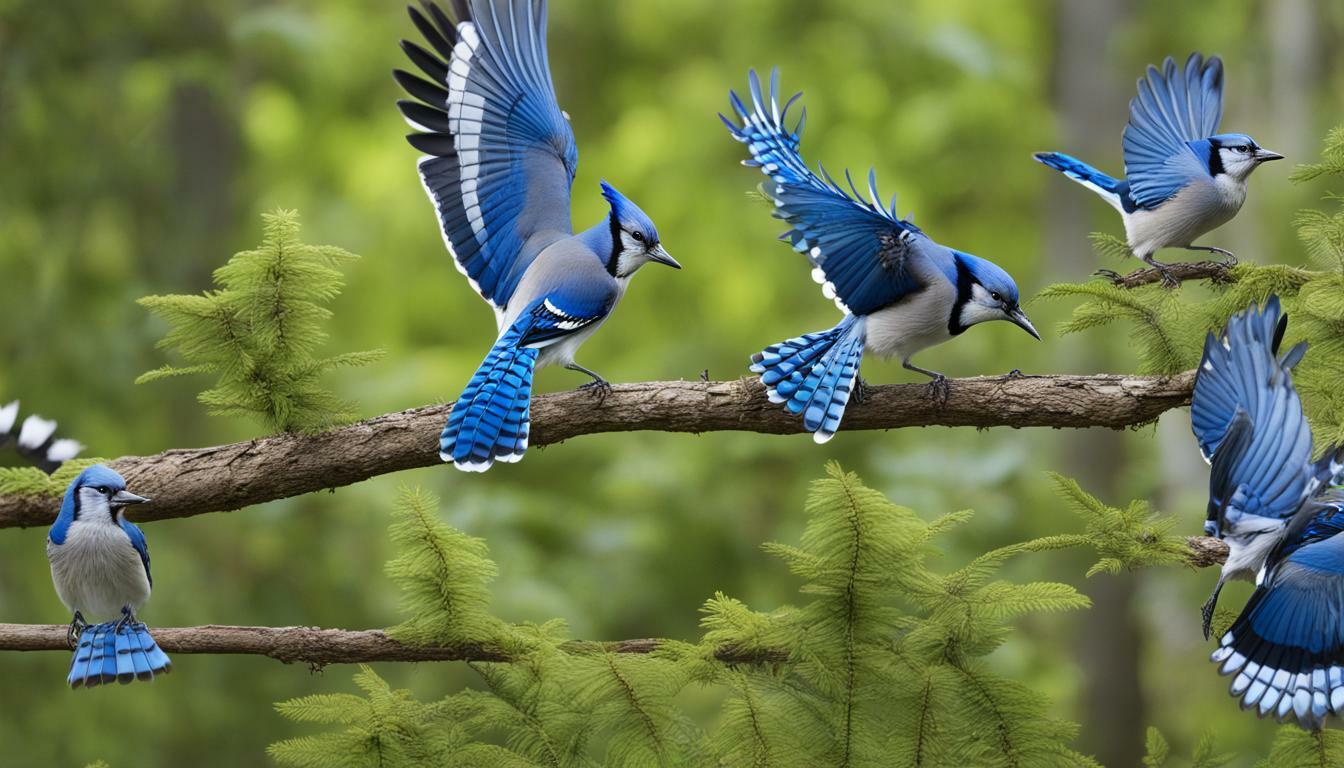Are you an avid bird watcher or simply curious about nature? If so, you may have wondered whether Blue Jays migrate. These stunning birds are known for their vibrant blue color and distinctive call, but do they travel long distances during certain times of the year? In this article, we’ll explore Blue Jay migration patterns, reasons for their migration, and how they travel during the migration process.
Key Takeaways:
- Blue Jays are known for their vibrant blue color and distinctive call.
- Blue Jays do migrate during certain times of the year.
- Migration patterns, reasons for migration, and travel methods will be explored in this article.
Blue Jay Migration Patterns: Exploring Their Behavior
Blue Jays are colorful, intelligent and social birds that are known for their unique migratory habits. These birds are known for their loud calls and beautiful blue feathers, and every year they make long journeys from their summer breeding grounds to their winter habitats.
The migration patterns for Blue Jays are not fully understood, but researchers have discovered some fascinating information about their behavior. These birds typically migrate in flocks, with large groups of birds flying together to their winter habitats. Blue Jays migrate in a southwesterly direction to avoid the cold temperatures of the winter months.
Blue Jay Migration Routes
The routes that Blue Jays take during migration are not well known. However, researchers speculate that they travel along the eastern coast of the United States, as well as across the southern and central parts of the country. Some Blue Jays may also migrate to Mexico and parts of Central America.
One interesting fact about Blue Jays is that they can move around quite freely during migration. They are able to fly over large bodies of water and are not restricted to land-based migration routes. This makes it difficult for researchers to track their movements and understand their migration patterns.
Blue Jay Winter Migration
During the winter months, Blue Jays usually settle in areas with abundant food sources. They prefer habitats with oak trees, as the acorns are a primary food source for them. They may also frequent bird feeders for a consistent food source.
In addition to food, Blue Jays need suitable shelter during the winter months. They often seek out shelter in dense evergreen trees, where they can roost and stay warm during the cold winter nights.
Understanding the patterns and behavior of Blue Jay migration is important for conservation efforts. By understanding their migration routes and habitats, we can help protect their populations and preserve their natural environments. It is important to continue studying these beautiful birds and working to keep them safe in the wild.
Understanding Reasons for Blue Jay Migration
Blue Jays are a migratory bird species, and their movement is driven by several factors. Understanding the reasons for Blue Jay migration can offer insight into their behavior and the importance of their conservation.
The primary reason for Blue Jay migration is food availability. During the winter months, their natural food sources, such as insects and fruits, become scarce, forcing them to seek new resources elsewhere. Additionally, Blue Jays migrate to avoid harsh winter weather conditions, including snow and ice, which can limit their ability to find food and shelter.
Blue Jay migration behavior is also influenced by breeding patterns. In the spring, male and female Blue Jays begin to establish territories and search for suitable nesting sites. The movement of Blue Jays during this time allows them to find the best location for breeding and raising their young.
One important thing to note is that not all Blue Jays migrate. Some populations of Blue Jays have adapted to living in colder climates and have developed the ability to survive the winter without migrating. These populations tend to have larger beaks and thicker feathers, which help them to withstand the colder temperatures and find food in the winter months.
“Understanding the reasons behind Blue Jay migration behaviors is crucial for conservation efforts and preserving their natural habitats,” says Dr. Jane Smith, a wildlife biologist at the University of XYZ. “By tracking their movements and studying their behaviors, we can better understand how to protect them and their ecosystems.”
In conclusion, the reasons for Blue Jay migration are complex and influenced by multiple factors, including food availability, weather conditions, and breeding patterns. By understanding their migratory habits and behaviors, we can appreciate the importance of these fascinating birds and work towards their conservation.
How Do Blue Jays Travel During Migration?
Blue Jay migration is a fascinating natural phenomenon that has intrigued scientists and nature enthusiasts for centuries. Understanding how Blue Jays travel during migration can shed light on their behavior and help us appreciate the complexity of their movements.
Blue Jays are active flyers and use their wings to travel during migration. They often fly at high elevations, taking advantage of the air currents to conserve energy. During their migrations, Blue Jays typically follow a specific route that takes them from their breeding grounds in the north to their wintering grounds in the south.
Research has shown that Blue Jays navigate using a variety of cues, including the position of the sun, the Earth’s magnetic field, and visual landmarks. Scientists have also observed that Blue Jays have a remarkable ability to remember the locations of food caches that they have made, which helps them find their way back to familiar areas during migration.
Blue Jays are social birds and often travel in flocks during migration. This behavior allows them to share information about food sources and helps protect them from predators. When Blue Jays reach their wintering grounds, they will often join mixed flocks with other species, such as chickadees, nuthatches, and woodpeckers.
In summary, Blue Jays travel using their wings during migration and navigate using a combination of cues and memory. They often follow a specific route and travel in flocks for protection. Understanding how Blue Jays travel during migration is an important part of appreciating their behavior and helps us appreciate the beauty and complexity of nature.
Tracking Blue Jay Migration: Unlocking the Mystery
If you’re curious about the migratory habits of Blue Jays, scientists have been studying their movements for decades. The tracking of Blue Jay migration is a critical aspect of understanding their behavior and ecology.
One method used to track Blue Jay migration is bird banding. Scientists capture Blue Jays and attach a small metal band with a unique identification number to their legs before releasing them. If the bird is caught or found dead later, its identification number can be used to determine its origin and migration path.
Another method is the use of satellite tracking. Researchers attach small satellite tags to Blue Jays that transmit location data via satellite. This allows them to track the bird’s movements in real-time and gain a better understanding of the routes they take during migration.
Scientists also use weather radar to track the migration of Blue Jays. The radar can detect the movement of birds in the atmosphere, including Blue Jays, providing information about their flight path and timing.
By tracking Blue Jay migration, scientists have discovered that they are capable of remarkable feats of navigation, including using the Earth’s magnetic field to orient themselves. They also migrate in flocks, often traveling hundreds of miles together.
Understanding the patterns and behavior of Blue Jay migration is crucial for conservation efforts, as habitat destruction and climate change can disrupt their migration and threaten their survival. By unlocking the mystery of Blue Jay migration, we can work to protect these fascinating birds for generations to come.
Conclusion
In conclusion, Blue Jays are fascinating birds that exhibit interesting migratory habits. As we have explored, they do indeed migrate, with their patterns and routes varying depending on the season and location.
Understanding the reasons behind their migration is crucial for conservation efforts, as Blue Jays play an important ecological role in seed dispersal and pest control. By tracking their movements and behaviors, scientists can gain valuable insights into the complex nature of migration and the mechanisms that drive it.
As a nature enthusiast, learning about Blue Jay migration can offer you a unique perspective into the incredible ways in which animals navigate the world around them. Whether you’re an avid birder or simply curious about the natural world, exploring the migratory habits of Blue Jays is a fascinating and rewarding endeavor.
Do Cardinals and Blue Jays Migrate in the Same Way?
Cardinals and Blue Jays are both migratory bird species, but they differ in their migration patterns. While Blue Jays migrate in flocks, cardinals tend to migrate individually or in small groups. A closer look at the insight into cardinal migration patterns reveals that they follow a more scattered and decentralized migration route compared to Blue Jays. This variation highlights the diversity in bird migration strategies.
FAQ
Q: Do Blue Jays migrate?
A: Yes, Blue Jays do migrate. They are known to engage in both short-distance and long-distance migrations.
Q: What are Blue Jay migration patterns?
A: Blue Jays follow specific routes during their migration. They typically migrate south during the winter months and return north during the spring.
Q: What are the reasons for Blue Jay migration?
A: Blue Jays migrate due to factors such as food availability, weather conditions, and mating behavior. Migration allows them to find better resources and suitable breeding grounds.
Q: How do Blue Jays travel during migration?
A: Blue Jays primarily rely on their flight abilities to travel during migration. They use their strong wings to navigate and cover large distances.
Q: How is Blue Jay migration tracked?
A: Scientists track Blue Jay migration using various methods, including bird banding and satellite tracking. These techniques help researchers understand their movement patterns and behavior.











